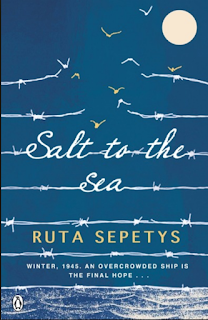Salt
to the Sea
By
Ruta Sepetys
(Penguin,
391pp, £7.99)
Ruta
Sepetys’ third novel, Salt to the Sea,
takes a little known Second World War humanitarian disaster, and makes out of
it an intelligent, uncompromising novel for young adults, with a narrative that
grips so fiercely it’s nigh on impossible to stop reading.
It’s
1945, and the Soviets have invaded East Prussia. Everyone is fleeing to the
port of Gotenhafen, in Poland – Lithuanian “volk”, whom Hitler settled in the
disputed province; Poles (firmly on the list of enemies of the fatherland); and
Germans themselves, from the fur-clad officers’ wives to the lowest deserter.
The rush
of people brings a small group of refugees together, and in their composition they mimick
the families they’ve lost: an old shoemaker, a little boy, a giant woman; and
three teenagers, whose compelling voices form the backbone of the book. Sepetys
uses the now-common YA technique of following several characters in the
first
person. Here it is entirely suited to the breathless, terrifying feat of
survival that her young protagonists must endure. There is Florian, a
handsome
Prussian boy, disillusioned with his masters and carrying a priceless
treasure;
Johana, a Lithuanian nurse still in her teens, capable and tender; and
most poignant,
Emilia, a Pole, raped by Russians, and pregnant with the child of one of
her
attackers. She sees Florian as “the Prussian Knight” – a character in a
fairy
tale. She herself is like a child from legend; her innocence cruelly
crushed.
Each short section ends on a cliff-hanger. They are constantly
endangered, and
always reliant upon their wit and their common humanity to survive. The
teen protagonists highlight the vulnerability of the refugees, whilst
allowing any reader to fully immerse themselves in their experience.
Interleaved
with their urgent tales are the thoughts of Alfred, a junior, near-sociopathic
Nazi, who is preparing the ships for the refugees. Obsessed with the purity of
the Aryan “race”, he walks around singing a list of the enemies of the Reich. He
composes letters to his sweetheart which he never sends – the disjunction
between the grandiosity of what he says, and the sickening reality around him,
is almost too much to bear.
One
of the major themes of Salt to the Sea
is deception. Florian was trained to be an art forger to help the Nazis steal
art; horrified, on realising his role, he decides to betray the Reich using
those very skills. “Did war make us evil or just activate an evil already
lurking within us?” he wonders. Just how far do people have to go in order to save
themselves, and others? What price morality when everything is bent out of
meaning?
The
refugees’ desperation is shown unsparingly. “I couldn’t remember not being
fearful and hungry,” says Emilia. They tramp for miles, terrified, haunted,
each carrying a secret, each longing for safety. There are many vivid, horrible
deaths, of named and unnamed characters. When they reach Gotenhafen, the crisis
there is another tragedy whose black outlines lurk inescapably in the future.
Tens of thousands of human souls clamour for succour: women, left on shore,
hurl their babies to sailors; the babies fall into the sea, and the women jump
in after them. Self-sacrifice and pity abound, but in all the wrong places.
What
happens next will be known to keen students of the period, but to most of us it
will be new. Sepetys has done a great service to the memory of those involved
in the disaster in bringing this horrifying story to light, and investing it with such
passion and energy in such a carefully crafted piece of fiction.
There
is respite, shown in an epilogue, which demonstrates that humanity heals, and
does not forget. But yet what terrible shadows we cast behind us, and how far they reach.


No comments:
Post a Comment